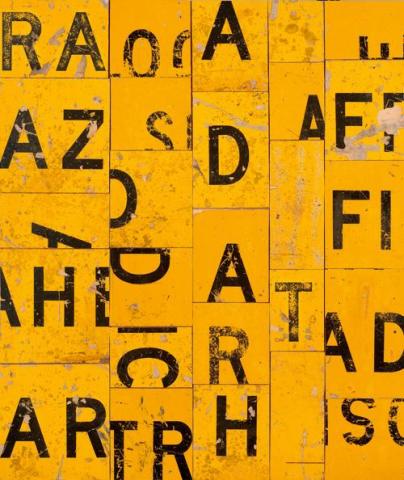ALL THAT GLISTERS, 1989
Rosalie Gascoigne
sawn retro-reflective road signs on board
130.0 x 109.0 cm
signed, dated and inscribed verso: ALL THAT GLISTERS/1989/ Rosalie Gascoigne
Private collection, Sydney
Acquired by the current owner, through Amanda Love Art, Sydney in 1999
Private collection, Sydney
Rosalie Gascoigne, Roslyn Oxley9 Gallery, Sydney, 31 October- 18 November 1989, cat. 5 (label attached verso)
Macdonald, V., Rosalie Gascoigne, Regaro, Sydney, 1998, p.106
Lynn, E., 'Mood, mass and melancholy', The Weekend Australian, 11-12 November 1989, p.10 (illus.)
'...Judging by the red spots, Rosalie Gascoigne's 23 works at Roslyn Oxley9 have been, as they say, eagerly anticipated...'1
Of all of Rosalie Gascoigne's achievements, undoubtedly the most striking and widely celebrated are her black-on-gold assemblages which incorporate printed planks cut from wooden Schweppes soft drink crates or retro-reflective road signs. Executed the same year as Gascoigne's monumental Monaro (Art Gallery of Western Australia), All That Glisters,1989, featured alongside this iconic work at the artist's inaugural exhibition with Roslyn Oxley9 Gallery in 1989, and significantly, was selected by esteemed art critic Elwyn Lynn as the image to accompany his review of the groundbreaking show.
Discussing the use of the reflective yellow road signs that dazzle so brilliantly in works such as All That Glisters, MacDonald illuminates thus the artist's discovery of her first cache of 'retro' amidst a road gang's tangled debris: 'She gathered together a sackful of this stuff as a "road-mending kit" for her grandchildren in Tasmania... and stacked the remainder in her courtyard. The yellow signs sat there, forgotten, too bright for her taste: "It's pretty hideous when you see it in the flesh; I didn't take much notice of it." Then one day it rained and she saw the gleaming signs anew. "I knew the material, I'd rejected it... then it took me on my blind side."'2
Like the best of her work, All That Glisters does not symbolise the landscape but rather 're-presents' it, each fragment of road sign evoking memories and associations particular to the individual viewer. With text thus skilfully transformed into texture, such works have not surprisingly been described as 'concrete, stammering poems'3- a perceptive analogy, especially giventhe artist's predilection for poetry. Notwithstanding, Gascoigne stresses that the flickering word fragments, though carefully arranged, are not intended to be read literally: 'Placement of letters is important, but it's not a matter of reading the text- it's a matter of getting a visually pleasing result.'4
Similarly, her titles are not literal but 'leave room for the viewer', imbued with multiple levels of meaning to be deciphered. A sophisticated yet playful pun, All That Glisters references most obviously Shakepeare and the oft-quoted line from his Merchant of Venice '...all that glisters is not gold.' More subtly, such title perhaps alludes to the artist's noted preference for the 'naturalness' of the Australian landscape by comparison to the 'ornateness' of Venice which she had experienced during her visit to represent Australia in the Biennale in 1982. Indeed, the adage encapsulates well the very essence of Gascoigne's vision- that beauty and truth reside in the most ordinary, unprepossessing of objects.
1. Lynn, E., 'Mood, mass and melancholy', The Weekend Australian, 11-12 November 1989, p.10
2. MacDonald, V., Rosalie Gascoigne, Regaro, Sydney, 1998, p.35
3. ibid., p.34
4. ibid., p.35
VERONICA ANGELATOS
